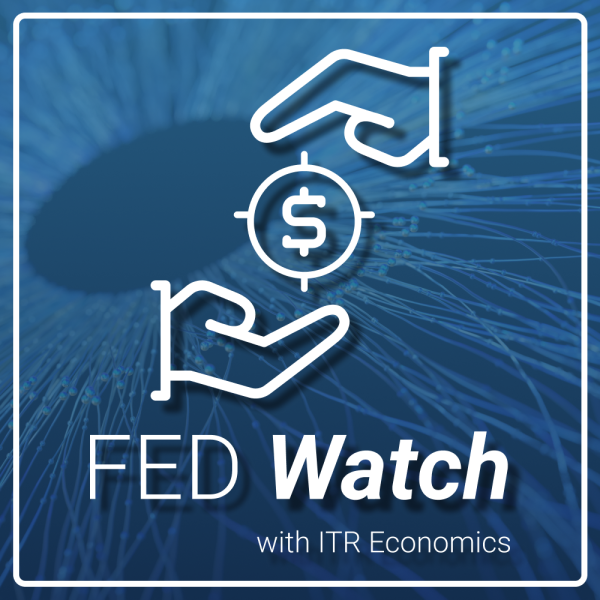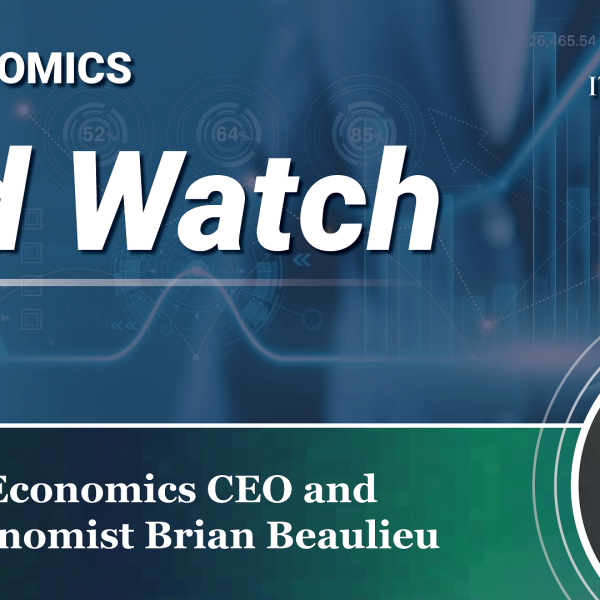- Mon - Fri: 8:30 - 5:00
- +1-603-796-2500
- ITR@itreconomics.com
with Brian Beaulieu
WEEKLY FED WATCH
Join us on Fed Watch as ITR Economics Chief Economist Brian Beaulieu provides an update on disappointing GDP data, highlights the upside activity we are seeing, and outlines our expectations for interest rates going forward.
Key Episode Takeaways
- 0:35 – Disappointment in GDP data
- 1:05 – Consumer spending kept the number afloat
- 1:54 – The money supply declined to its lowest point
- 2:29 – The savings rate also went down
- 3:19 – Real personal income data, excluding government transfer payments
- 3:46 – Upside activity we are seeing
- 4:22 – More good news we are seeing from the Personal Consumption Expenditure Price Index
- 5:11 – High growth rate in wages, although that growth has begun to slow down
- 5:45 – Interest rate expectations and actionable advice
The below transcript is a literal translation of the podcast audio that has been machine generated by Rev.
Hello. Welcome to this edition of Fed Watch. I’m Brian Beaulieu. Today is April 26, 2024, and there’s a lot going on, so let’s unpack it. I’m not going to get into all the data, but this was a data-heavy week and the news was really mixed as far as what the future holds for interest rates. GDP, you probably read, was disappointing for a lot of people. It showed a 1.6% annualized growth rate, so there’s a considerable slowdown in that seasonally-adjusted annualized rate. Our 312 rate of change also moved down. Looks like we’re going to have a December, 2023, 312 high. So the economy is shifting into a different gear, and we are in that slowdown phase for 2024 that we’ve been forecasting.
And the details of the GDP showed that consumer spending kept the number afloat by and large, but there were spending on service sector. Consumer spending on goods was actually a negative in terms of the growth rate for GDP, and we saw that in the North American automobile production numbers, where the 112 rate of change for March actually went negative, so they were producing less cars in March ’24 than they were in March ’23. And last week we had talked about how automobile retail sales were showing some weakness, so the manufacturing sector seems to be reacting to that relatively quickly. And that ties in with that GDP softness in the goods side of things.
Also pointing to a more slowdown in the rate of growth. The money supply, which hadn’t been holding fast for several months, went down with the latest data, down to its lowest point in about four years now. Rates of change are continuing to edge up, but the Federal Reserve still has that tightening going on in the money supply, and that’s going to have a dampening effect on retail sales as we go into the second quarter and third quarter, and it’s part of this longer-term slowdown.
The savings rate went down to 3.2%. It had been at, I think, it was 3.8% the prior month, so people are in this interesting position of they wanted what they want, they’re spending but they’re not saving. And 3.2%’s really a low rate in the post-Great Recession history. It was normal before the Great Recession. Could be that they’re just making a move where we saw some improvement in the housing data, so maybe they’re drawing down in their savings or they’re not saving as much. Anyways, both things happen to be going on because they’re furnishing these homes, and that’s a piece of good news for future us. The drawdown on the saving isn’t a great piece of news in the near term.
And real personal income, excluding government transfer payments, also slowed down. That slowed down to a 2.3% year-over-year growth rate, 2.5% for the first quarter. So that, also combined with the lack of savings, is going to mean consumers are likely going to be cooling off further as we go into the second quarter, third quarter, and maybe even the fourth quarter.
We’re seeing some upside activity going on. New home sales, nice strong rising trend going on in the three-month moving total. That’s seasonal, but it’s slightly better than average on the seasonality, and the rates of change have picked up, and the 12th already change actually broke into phase B up. So we have over 12th of a plus 1.0%, and that’s a good leading indicator for 2025. It doesn’t mean we’re not going to feel all the sluggishness that I was just talking about in ’24. That’s a 2025 indicator.
The other good news, and it didn’t come across this way in the media, but personal consumption expenditure price index, excluding food and fuel, so core PCE, stayed flat at 2.8%. The media picked up a lot on how the overall price index was at a 2.7% rate of growth, slightly elevated, but the core rate stayed flat in its 112, and that’s an important barometer. It’s not like what the CPI did. It’s not like what the overall PCE did, price index. So that’s going to give the Federal Reserve some maneuvering room if the economy continues to slow down. We may be seeing some moderation in the rate of inflation as the economy slows down.
Wages have been on a tear, and construction has been fed a lot of activity thanks to all the bills, programs coming out of Washington, and manufacturing continues to see a high rate of growth in wages, although that has gone into phase C. But it’s taking a lot longer than normal to see that deceleration in wages, particularly in the manufacturing sector. It should be coming, and that’s going to buy the Fed, again, some maneuvering room.
The Futures market is suggesting only a 46% chance of interest rate decline and not sooner than September. That’s a significant change from just two months ago, where they were about an 80% probability of decline. I’m still thinking that it’s going to be in the third quarter, September being part of that third quarter. It’s a little later than I had expected because of the ongoing inflation, but I’d still be looking at the third quarter start of some interest rate decline based on the weakness we’re seeing in the goods sector and the drawdown in savings, and that’s going to impact retail sales. So I wouldn’t give up on those interest rate declines happening in the second half of this year. Just going to be a bit later than we thought it was going to be. Don’t forget to grab those interest rates when they do come down because we’re still looking at inflation rearing its ugly head again on the other side of this particular business cycle.
Thanks for watching this edition of Fed Watch. See you next week.





